Legislative environment for window cleaning
It is of course in their own interests that building owners protect themselves and prevent potential damage and renovation work which may be necessary. For this, regular inspections, maintenance measures, and cleaning tasks on the facades and windows are necessary. Even if builders and architects are legally obliged to take into account all related safety aspects during their planning, window cleaning is linked to enormous potential dangers which depend on the building and facade characteristics. Falls are amongst the most frequent accidents at work – and quite frequently these also result in death. Employers are therefore legally obliged to keep the numerous risks related to window cleaning, for example, to as low a level as possible, in order to protect their personnel appropriately. As a facility manager, you therefore bear a huge responsibility with respect to your employees.
Here are the relevant directives at a glance(Official Journal of the European Communities):
- 89/656/EEC“Minimum health and safety requirements for the use by workers of personal protective equipment at the workplace”
The Official Journal of the European Communities states “Compliance with minimum requirements for the improvement of safety and of the protection of health when using work equipment is an essential prerequisite for ensuring safety and for the protection of health of employees”. All these regulations represent minimum standards which you can of course further optimise by means of individual improvements adapted to the actual on-the-spot situation.
Standards for fall prevention for windows
Very often, the glass surfaces to be cleaned are accessible only with great difficulty, and this requires the use of various ascent aids. As soon as the fall height exceeds 60 cm, fall prevention systems are required for windows under certain circumstances. Viewed from the employee’s standing location, the following reaches apply: approx. 1.8 metres upwards and 0.5 metres to either side. Where the cleaner must bend outwards over a porch or balustrade, then a reach of 0.6 metres applies. In this case, to allow the work to be performed from floor level, the balustrade must also be at least 95 cm high. If these limits are exceeded or fallen short of respectively, then technical equipment including correct fall protection is mandatory.
How high does fall protection need to be?
In principle, for window cleaning, safety measures which work collectively, such as permanently installed fall protection systems (barrier frames or railings), are preferable. If these cannot be implemented in the specified location, then suitable personal protective equipment (PPE), such as a safety harness, must be used. This must be attached to stable components or anchor devices which have an arresting force of at least 7.5 kN. The height of the fall protection depends on the fall height, and must be at least 100 cm. From a fall height of 12 metres, the minimum height of the protection must be 110 cm (always measured from the cleaner’s standing surface).
In addition, window ledges may be used as standing surfaces for cleaning only if they have a minimum width of 25 cm and a sufficient load-bearing capacity. Working locations at a height exceeding two metres require either a permanent installation or temporarily installed equipment such as raised working platforms or scaffolding which are correctly attached and suitably load-bearing. In principle, most requirements relating to fall prevention for windows are based on common sense. You can obtain further information via the following links:
Preparation for work
Before starting the window cleaning tasks, the dangers must be determined and the necessary safety measures must be taken. Because no two buildings are the same, and therefore new challenges can be always expected even when cleaning windows, the sources of danger can of course also be very variable. As a facility manager, you should therefore analyse the working areas of your employees very closely and identify any potential risks. Only in this way can you be in a position to define and implement the correct safety measures. For this, the distinction between the terms “danger” and “risk” is of central importance – for this refer to blog post “7 steps of risk assessment”.
When determining and assessing the dangers and risks for your window cleaning team, you can take the following seven steps:
Assessing the risks:
- Record the work areas & activities
- Determine the risks
- Assess the risks
- Specify protective measures
- Implement the measures
- Check their effectiveness
- Document & keep updated
When it comes to determining fall risks, then above all the following parameters should be taken into account:
- The height difference between the fall edge and the lower-lying surface, as well as its characteristics, so that it can be ascertained what may happen to the affected employee in the event of a fall (sinking, asphyxiation, drowning, impalement, caustic attack …)
- Distance from fall edge
- Are the activities physically light, strenuous, short-term, or over an extended period?
- Weather conditions, e.g. frost, storms, heat, ...
- Also conditions of visibility or backlighting
In addition, when planning the safety measures, proceed as per the (S)TOP principle (Substitution, Technical and Organisational measures, as well as Personal protective measures).
Potential equipment
The different types of equipment are distinguished as follows:
- Collective protection such as facade railings or side protection
- Alternative working equipment, which includes roller scaffolds, raised working platforms, or platform ladders, as well as
- Personal protective measures and
- Organisational measures.
Window cleaning which complies with the regulations also includes equipment such as steps, ladders (while complying with the instructions for use) and window ledges, which must be used when the windows cannot be safely accessed from the ground. Here, large heights between storeys (greater than two metres) represent a particular risk, and so preferably permanently installed safety equipment should be used. If these technical safety measures cannot be implemented, then measures related to the individual should be introduced.
Potential ascent aids
It will come as no surprise that office chairs or even drinks crates are not listed as approved ascent aids in the regulations. Instead, steps or ladders must be used. In addition, suitable, slip-resistant footwear should be worn, and bulky or heavy objects should not be carried.
Ascent aids in detail:
- Steps with or without rollers. These are suitable for ascents of up to one metre in height. Steps with rollers must be braked when under load, and it must not be possible for them to fold together unintendedly. In addition, steps must be coated with a slip-resistant surface.
- For ladders, a distinction is made between single ladders, stepladders, and extension ladders. The first of these must stand on a safe surface and are mainly intended for shorter, less demanding tasks. For extension ladders, it must always be ensured that the extension engages into the lower part. Stepladders must not be used as single ladders, because neither the feet nor the head of the ladder are designed for this use. Only if a safety bridge or holding device has been fitted may the top step or rung be mounted.
Cleaning windows completely safely
Particularly when cleaners of buildings have to lean out of the window to do their work, e.g. when cleaning top lights which do not open, there is a high risk of falling. In this case, from a fall height of one metre and above, fall protection must be provided. Preferably, these are collective safety measures such as guards or railings. If the location makes this impossible, then personal protective equipment is required. Walkways for cleaning must be at least 0.5 m wide, and they must not have openings larger than 35 mm. The workplace itself must be at least 0.5 m x 0.5 m in size.
Summary
Fundamentally, employers are responsible for the safety of their employees. The sources of danger and any potential risks should be identified and assessed in as much detail as possible, in order to take the appropriate safety measures. This is even more important because, from a statistical viewpoint, falling over and/or falling from height represent one of the most frequent accidents at work. The legal requirements should therefore be complied with very closely – otherwise, it is the employer who is liable.
Do you have further questions about this subject? Then simply contact us! The INNOTECH professionals are always pleased to help and advise you! Get our free checklist now! There we give you 5 tips about window fall protection.

















